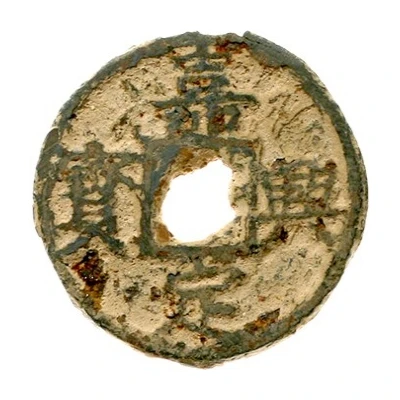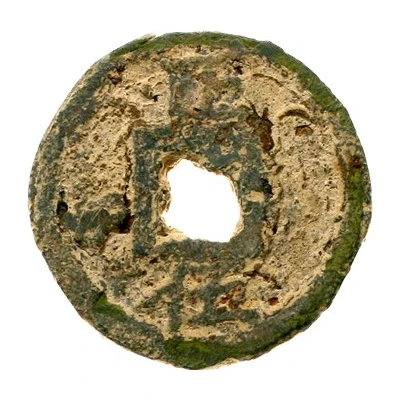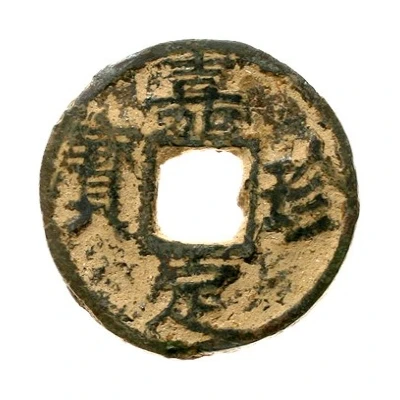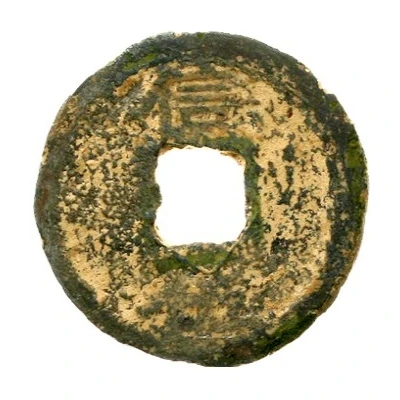


© Teutoburger Münzauktion
5 Cash - Jiading Xingbao; Zheng; iron ND
| Iron | - | 35 mm |
| Issuer | Empire of China |
|---|---|
| Emperor | Southern Song dynasty › Ningzong (宋寧宗) (1194-1224) |
| Type | Circulating commemorative coin |
| Years | 1208-1224 |
| Value | 5 Cash |
| Currency | Cash (621-1912) |
| Composition | Iron |
| Diameter | 35 mm |
| Shape | Round with a square hole |
| Technique | Cast |
| Orientation | Medal alignment ↑↑ |
| Demonetized | Yes |
| Updated | 2024-10-04 |
| Numista | N#219559 |
|---|---|
| Rarity index | 100% |
Reverse
One Chinese ideogram above and one below.
Script: Chinese (traditional, regular script)
Lettering:
正
伍
Translation:
Zheng / Wu
[Uncertain mint] / Value 5
Edge
Plain
Comment
It is uncertain which mint used this mintmark. With this mintmark appearing on both iron and bronze pieces, it is possible these coins were produced at the Old Yidu Mint in Sichuan, which likely casted both compositions after it reopened in 1129.The Old Yidu Mint diffinitely casted bronze pieces, which had the mintmark Chuan for Sichuan. And with this being a Sichuan mint, it is possible this mint also produced iron pieces. While this mint's old mintmark was Chuan, that was back in 1129-1130. A Zheng mintmark was used from 1170-1179, casting coins in both bronze and iron, so they may have changed their mintmark for an uncertain reason (possibly wanting something less generic than a mark for Sichuan). And with this being another Zheng mintmark coming from a Sichuan mint, they may have continued the mintmark for this series.
During the Jiading era, in addition to the regular Tongbao, Yuanbao, and Zhongbao coins, various other currency names are used:
- 安寶 (Anbao; peaceful currency)
- 崇寶 (Chongbao; noble currency)
- 大寶 (Dabao; large currency)
- 封寶 (Fengbao; honoured currency)
- 洪寶 (Hongbao; great currency)
- 隆寶 (Longbao; eminent currency)
- 泉寶 (Quanbao; type 1; wealthy currency)
- 全寶 (Quanbao; type 2; perfect currency)
- 万寶 (Wanbao; uncountable currency)
- 新寶 (Xinbao; new currency)
- 興寶 (Xingbao; prosperous currency)
- 永寶 (Yongbao; everlasting currency)
- 真寶 (Zhenbao; type 1; true currency)
- 珍寶 (Zhenbao; type 2; precious currency)
- 正寶 (Zhengbao; orthodox currency)
- 至寶 (Zhibao; type 1; best currency)
- 之寶 (Zhibao; type 2; the currency)
These all appear to be from mints in Sichuan; however, the exact purpose of these pieces (collectively known as the substitution series) is uncertain.
One possible theory is that, because the Jiading era lasted 24 years and there are exactly 24 coin in this series, a different currency name was used each year.
Interesting fact
One interesting fact about the Jiading (Xingbao; Zheng; iron) ND (1208-1224) circulating commemorative coin from the Empire of China made of Iron is that it was produced during the reign of Emperor Ningzong of the Southern Song dynasty, who ruled from 1194 to 1224. This coin was minted as a means of commemorating the emperor's military campaigns and victories, specifically his successful defense against the Mongol invasions. The use of iron in the production of this coin was significant because it was a departure from the traditional use of copper or silver in Chinese coinage, and it reflected the emperor's efforts to promote the use of iron in currency as a way to stimulate the economy and increase military production.

